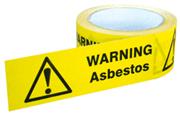
Asbestos Regulations for Renovation Contractors
1. The contractor is a licensed contractor in California.
2. The contractor is a certified building inspector under the Asbestos Hazard Emergency Response Act (AHERA).
3. The project takes place in a residential dwelling.
2. The contractor is a certified building inspector under the Asbestos Hazard Emergency Response Act (AHERA).
3. The project takes place in a residential dwelling.
The 100 SF threshold addressed in the Business and Professions Code applies only to whether a contractor is
required to have Department of Occupational Safety and Health (DOSH) asbestos registration. It does not
supersede the requirements of the Cal/OSHA Lead in Construction Standard which applies when removal or
disturbance of any amount of asbestos containing material takes place during construction related activities
(see below).
required to have Department of Occupational Safety and Health (DOSH) asbestos registration. It does not
supersede the requirements of the Cal/OSHA Lead in Construction Standard which applies when removal or
disturbance of any amount of asbestos containing material takes place during construction related activities
(see below).
The list below details asbestos bans by the United States in construction materials. Usage of many of the
banned materials continued for a number of years after the bans due to stockpiles accumulated before the bans
and illegal imports. It's important to realize that the banned materials listed represent only a fraction of all the
construction materials where asbestos can be found.
banned materials continued for a number of years after the bans due to stockpiles accumulated before the bans
and illegal imports. It's important to realize that the banned materials listed represent only a fraction of all the
construction materials where asbestos can be found.
This page discusses the major asbestos regulations that impact residential and commercial renovation projects.
The information provided can be summarized in these four bullets:
The information provided can be summarized in these four bullets:
- Unless you're an asbestos abatement contractor, you cannot remove or disturb any quantity of asbestos
containing material (ACM). - There is no cut-off date where asbestos can no longer be found in building materials. However, with a few
exceptions, the likelihood of finding asbestos in building materials decreases significantly after 1981 due
to government bans and voluntary phase-outs by manufacturers. - In non-residential renovation/demolition, an inspection for asbestos is required prior to disturbance
regardless of construction date. - A licensed contractor may collect up to 12 samples for asbestos analysis but the contractor must have
an AHERA building inspector certification and the project must be residential.
Asbestos Bans
1973 - banned by EPA in spray-applied surfacing material for fireproofing/insulating purposes.
1975 - banned by EPA in thermal system insulation.
1977 - banned by CPSC in consumer wall patching compounds.
1978 - banned by EPA in spray-applied surfacing material for "decorative" purposes.
1993 - banned by EPA in flooring felt (including sheet vinyl backing).
1975 - banned by EPA in thermal system insulation.
1977 - banned by CPSC in consumer wall patching compounds.
1978 - banned by EPA in spray-applied surfacing material for "decorative" purposes.
1993 - banned by EPA in flooring felt (including sheet vinyl backing).
Suspect Asbestos Containing Material
Classifying a material as suspect ACM is fairly simple for pre-1981 construction. In a nutshell, if it's not
constructed of wood, glass, or metal then it is suspect (click here for a list of suspect ACM).
constructed of wood, glass, or metal then it is suspect (click here for a list of suspect ACM).
California Business and Professions Code Section 7180(b)
A contractor may take up to 12 bulk samples of suspect asbestos-containing material that is required to be
removed, repaired, or disturbed as part of a construction project if all three of these requirements are met:
removed, repaired, or disturbed as part of a construction project if all three of these requirements are met:
If the material is pre-1981 thermal systems insulation or surfacing material, the sample collection has to be done
in accordance with AHERA 40 CFR 763.86 in order to rebut the designation of that material as presumed
asbestos containing material.
in accordance with AHERA 40 CFR 763.86 in order to rebut the designation of that material as presumed
asbestos containing material.
Confusion Over the 100 SF Provisions of the Business and Professions Code and Labor Code
If a contractor reads section 7058.5 of the Business and Professions Code, section 6501.5 of the Labor Code,
and neglects to read the Cal/OSHA Lead in Construction Standard (CCR Title 8 Section 1529), he may be led to
believe it's acceptable for him to remove up to 100 SF of asbestos containing material as part of a construction
project without the need of any specialized training, work practices, and certification. This conclusion (which
happens frequently) is completely inaccurate.
and neglects to read the Cal/OSHA Lead in Construction Standard (CCR Title 8 Section 1529), he may be led to
believe it's acceptable for him to remove up to 100 SF of asbestos containing material as part of a construction
project without the need of any specialized training, work practices, and certification. This conclusion (which
happens frequently) is completely inaccurate.
Cal/OSHA Asbestos in Construction Standard, CCR Title 8 Section 1529
NESHAP stands for National Emissions Standard for Hazardous Air Pollutants.
This EPA regulation applies to all structures except residential structures that
have 4 or less dwelling units. It requires an asbestos inspection prior to
renovation or demolition regardless of construction date. It also includes
notification and work practice requirements.
This EPA regulation applies to all structures except residential structures that
have 4 or less dwelling units. It requires an asbestos inspection prior to
renovation or demolition regardless of construction date. It also includes
notification and work practice requirements.
| Call or email for pricing or with any questions: 858-688-2868 jeff@sandiegotesting.com |

This regulation applies when asbestos containing material is removed or disturbed in any quantity during
construction related activities (except when a home-owner is doing work inside his own home). It addresses
work practices, certification, and training requirements for workers engaged in these activities. Among many
other requirements, workers must have AHERA certification as an asbestos abatement worker. Additionally, a
supervisor must be on site during the entire period asbestos is disturbed or removed and he must have AHERA
certification as an asbestos abatement supervisor.
construction related activities (except when a home-owner is doing work inside his own home). It addresses
work practices, certification, and training requirements for workers engaged in these activities. Among many
other requirements, workers must have AHERA certification as an asbestos abatement worker. Additionally, a
supervisor must be on site during the entire period asbestos is disturbed or removed and he must have AHERA
certification as an asbestos abatement supervisor.

In post-1981 construction due diligence must be used in categorizing a
material as suspect. Unfortunately, there is no clear consensus on the
extent of materials that should be included. Asbestos has been found in
NAFTA and Chinese imported materials and the US has banned asbestos
only in a handful of materials. Such uncertainties has created varying
opinions on what to consider suspect after 1981.
material as suspect. Unfortunately, there is no clear consensus on the
extent of materials that should be included. Asbestos has been found in
NAFTA and Chinese imported materials and the US has banned asbestos
only in a handful of materials. Such uncertainties has created varying
opinions on what to consider suspect after 1981.
Roof penetration/seam mastic - all construction dates.
Drywall joint compound (or skim coat) - through 1990.
Window glazing - through 1990.
Popcorn ceiling - through 1985.
Sheet vinyl flooring - through 1985.
Drywall joint compound (or skim coat) - through 1990.
Window glazing - through 1990.
Popcorn ceiling - through 1985.
Sheet vinyl flooring - through 1985.
Using the most current information available, San Diego Testing believes
it's reasonable to categorize the following materials as suspect:
it's reasonable to categorize the following materials as suspect:
EPA NESHAP Regulations 40 CFR 61 Subpart M

| Lead - Asbestos - Mold Experts in San Diego |
